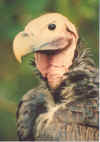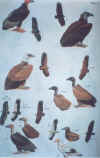|
|
the-south-asian.com February 2004 |
||||
|
February
2004 Environment Music Theatre Sports Real
Issues
Coffee
break
Lehngas - a limited collection
Books Between
Heaven and Hell
|
|
||||
|
CLIPPING THE WINGS OF THE VULTURE by Gyan Marwah The Indian King vulture...Falling prey to man.Over the past few years, wildlife enthusiasts are crying themselves hoarse that the stately vulture is vanishing from the Indian skies and flying towards extinction. But is someone listening....? Poets and writers have written eloquently on parrots, woodpeckers, hornbills, cuckoos and bulbuls, but few have spared a thought for the vulture. Even if the bird does find notice it is usually for the wrong reasons. Contrary to popular belief, vultures have a very vital role to play in the environment. They are the hardiest of God's creations and have been called nature's own disposal squads. Carcasses---rotting ones at that---are a vulture's typical diet and its scavenging habits are an important link in checking and containing the spread of infectious diseases among animals and even human beings. Whenever there are occurrences of cattle epidemics causing large-scale deaths or during natural calamities like floods and droughts, nature assigns the vulture with the job of cleansing the earth of putrid carcasses thus speedily preventing deadly germs from spreading. But over the past few years, gypsophils (vulture enthusiasts) are crying themselves hoarse that the stately bird is vanishing from the Indian skies and flying towards extinction. Increasing urbanisation, rampant use of pesticides in agricultural fields, mounting pollution and wide-scale killing of vultures are all taking their toll. Wildlife experts fear that if urgent steps are not taken, spotting a vulture may become as rare as sighting an Indian bustard. There are multiple explanations for the declining population of vultures. For one, experts believe that vultures are dying due to rapid habitation. "They don't belong in cities. It is the faulty waste disposal practices adopted by municipalities which led to vultures coming to the cities in the first place. They should be out there in the countryside", says an expert from World Wildlife Fund. But they are vanishing from the countryside as well. In fact, in several Asian countries like Vietnam, Thailand, Laos and even India, dead animals are no longer attracting vultures. Simply because there are not many left. In India a number of tribes in Andhra Pradesh, Karnataka and Maharashtra eat vulture meat. But what is more worrisome is the fact that villagers view these carnivores as aggressive predators with a penchant to swoop and lift their livestock. Though this may not be true, elaborate traps are laid out to kill these vultures, the commonest being to mix lethal poison in a carcass which kills these birds instantly. The increasing air traffic in big cities too has taken its toll. With the number of 'bird hits' going up alarmingly, the civil aviation and air force authorities have special squads to hunt down vultures which, because of their size, are a major threat to flying aircraft. A relatively less researched reason for the dwindling population is the rampant use of pesticides in farming. Recently, the Centre of Science and Environment (CSE) undertook a study of the eating habits of vultures around Delhi and Uttar Pradesh. The study revealed high incidence of deadly chemicals like DDT, aldrin, dieldrin and BHC in the stomach of these birds. The theory is that the cattle imbibe these pesticides from the grass and other green vegetation. When the cattle die, vultures swoop on the carcass and imbibe these chemicals along with the flesh of the cattle. Though DDT and other harmful pesticides are banned for agricultural purposes, they are still distributed by block development officers for control of mosquitoes and other harmful insects. Scientists feel the quantities of pesticides found in carcass may or may not be the cause of the death of cattle but once they are consumed by the comparatively small-framed vultures, they lead to disorders in their reproductive organs, even causing thinning of their egg shells which further results in high mortality rates. For most experts this is worrisome, because vultures lay no more than two or three eggs and that too just once a year. Researchers studying their dwindling population have found that pesticide residue causes almost a 20 percent thinning in the egg-shells, making them vulnerable to the elements of nature, premature hatching and also being prey to predatory birds. It has been observed that vultures normally hover over areas where meat of animals is available in plenty - for instance, in the neighbourhood of slaughter houses or chicken farms. According to experts only one species (vultures are hostile to vultures of another species), congregates at a food site. This means that there is no cross-group mating among vultures in one area. Inbreeding reduces fertility and survival possibility of newly hatched babies. In India there are eight species of vultures, the commonest being the Indian Scavenger which is found practically all over the country. All species prey on mammals for food. However, over the years, a number of species like the Indian King, Long-Billed Griffon, India Fulvous, Asian White Rumped and the Himalayan Griffon, which inhabited the Himalayas but were also seen around north India, have become a rare sight these days. Many have simply vanished and may only be found in high mountain ranges. Though no extensive research has been undertaken, a study done by scientist Dr. Vibhu Prakash at the Keoladeo National Park in Bharatpur in Uttar Pradesh is indicative of the threat to vultures. Dr. Prakash has kept track of the bird since 1985. His findings suggests that there were approximately 95 Asian White Rumped vultures on his last count in 1998 against over 2,000 some 14 years ago. The next most common species in the area, the Long- Billed Griffon, hasn't been sighted in the park this year. It is statistics like these which have prompted scientists to sound the alarm bells. And though, going by the common perception, it is good riddance to the flying scavengers, the fact is that once the vultures disappear, disease and pestilence may follow. Even the great ornithologist, Dr. Salim Ali in The Book of Indian Birds described vultures as God's own incinerators, which cannot be replaced by even the most sophisticated ones which man may invent. *****
|
|||||
| Copyright © 2000 - 2004 [the-south-asian.com]. Intellectual Property. All rights reserved. | |||||
| Home | |||||

